Cosmology, Astro- and Astroparticle Physics
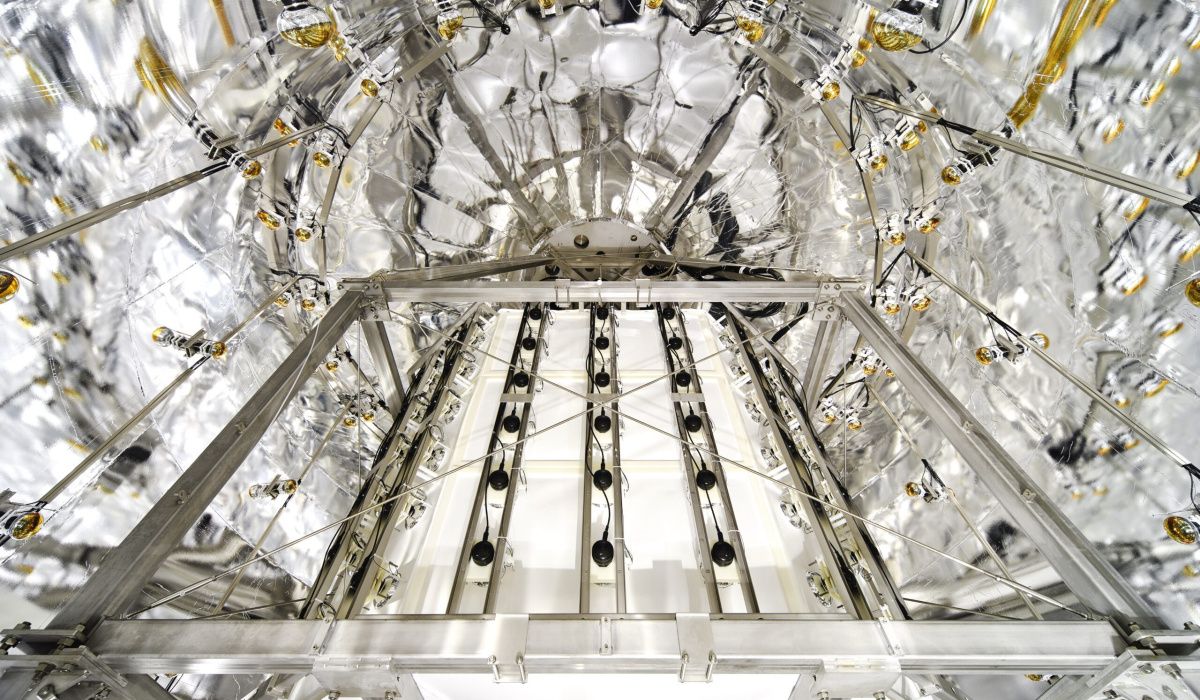
Table of contents
- Prof. Philippe Jetzer - Astrophysics and General Relativity
- Prof. Prasenjit Saha - Theoretical Astrophysics
- Prof. Prasenjit Saha, Prof. Nico Serra - CTA – Cherenkov Telescope Array
- Prof. Laura Baudis - Astroparticle Physics Experiments
- Prof. Ben Kilminster - DAMIC Experiment
- Groups from the Institute for Astrophysics
Prof. Philippe Jetzer - Astrophysics and General Relativity
LIGO (Laser Interferometer Gravitational-Wave Observatory) consists of two Earth-bounded instruments together with Virgo aimed to detect gravitational waves in the frequency range from about 10 to 1000 Hz. In 2015 the first gravitational wave signal has been detected. Since then more than 100 events have been found. Our group has made important contributions to the analysis of LIGO/Virgo data and in the modelling of more accurate gravitational waveforms. The latter results are used in LIGO/Virgo data analysis and in future for the LISA mission and the Einstein Telescope project.
The work of the group is focused on the topic of gravitational waves in the framework of the LIGO Scientific Collabora- tion and for the future space mission LISA, since our group is involved in both of these international collaborations. In the following we briefly describe some results published in 2023, besides all the works appeared in the framework of the LIGO/Virgo, LISA Pathfinder and LISA collaborations.
P. Jetzer as a member of the LISA Science Working Team of ESA was involved in the writing of the Definition Study Report for LISA. This report is an important contribution towards the so-called Mission Adoption of LISA, which was decided on 25 January 2024, and which marks the end of vari- ous study phases and the beginning of the construction of the satellites.
Gravitational wave detections offer insights into the astrophysical populations of black holes in the universe and their formation processes. Detections of binaries consisting of black holes lying outside the bulk distribution of the astrophysical population are particularly intriguing. In a study by Y. Xu and E. Hamilton, they investigated the detectability of precession and its potential degeneracy with eccentricity in some gravitational wave events. They found that eccentricity lower than 0.2 is insufficient to mimic precession in param- eter estimation when assuming a quasicircular signal. Thus their results suggest that a certain degree of precession is nec-essary to produce evidence of high precession in parameter estimation, but it remains challenging to conclusively deter- mine which effect is responsible for the high precession observed in events like GW190521.
E. Hamilton with L. London and M. Hannam found a simple formula for the effective ringdown frequencies of the gravitational-wave signal of a precessing black-hole binary in the coprecessing frame. This formula requires only knowledge of the quasi-normal mode frequencies of the system and the value of the precession angle β during ringdown. Such a formula will be useful in modeling precessing systems. They also provide a comprehensive description of the oscillations in the ringdown frequency in an inertial frame where the spin of the final black hole is orthogonal to the orbital plane. These oscillations arise due to the superposition of the prograde and retrograde frequencies.
-

- Zoom
-
Figure: LISA will consist of three spacecraft, millions of kilometres apart, following the Earth on its orbit around the sun. The spacecraft will send signals to each other and the interference patterns will enable scientists to reconstruct the gravitational waves in space. (Image: AEI, MILDE)
Highlighted Publications:
- Measurability of precession and eccentricity for heavy binary-black-hole mergers
Y. Xu, E. Hamilton, Phys. Rev. D107 (2023), 103049 - Ringdown frequencies in black holes formed from precessing black-hole binaries
E. Hamilton, L. Londan, M. Hannam, Phys. Rev. D107 (2023), 104035, arXiv:2301.06558.
Prof. Prasenjit Saha - Theoretical Astrophysics
Our research has been on diverse astrophysical phenom- ena involving light and gravity, especially gravitational lenses, but also novel applications of spacecraft ranging.
Galaxies and clusters that create multiple mirages of back- ground galaxies through gravitational lensing have long been understood as a probe of dark matter and indeed the process of galaxy formation. We have continued our long-running re- search program in this area, and also studied less- explored regimes of lensing, such as strong gravitational fields.
In other work we have continued our study of a future Uranus mission and similar spacecraft as a detector of long- period gravitational waves, in the gap between the LISA and PTA ranges.
-

- Zoom
- Figure: Wavefronts and light travel times near a black hole, similar to those arising in the famous photon-ring images around the M87 black hole.
- Highlighted Publications:
- What are the parities of photon-ring images near a black hole?
A. Meena, P. Saha, The Open Journal of Astrophysics, vol. 6, id. 50 (2023)
Prof. Prasenjit Saha, Prof. Nico Serra - CTA – Cherenkov Telescope Array
The Cherenkov Telescope Array (CTA) is a next-generation facility to observe high-energy sources in the Milky Way and beyond. It is designed especially for gamma-ray photons from 10 GeV to above 100 GeV, which it will detect indirectly, through optical Cherenkov showers in the atmosphere. Fortuitously, the facility will also have the capacity to operate in a completely different mode, as an optical intensity interferometer, which can image stellar-scale phenomena.
We have continued our developmental simulation work on the CTA, as well as contributing to the precursor telescopes of MAGIC in intensity interferometry mode to resolve stars below the milli-arcsecond range.
-
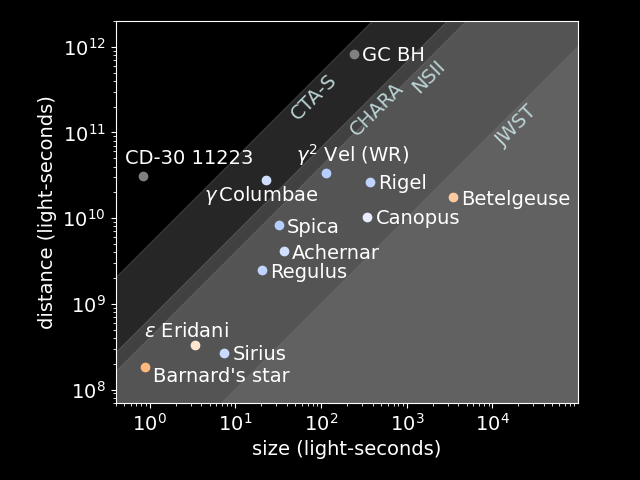
- Zoom (PNG, 54 KB)
- Figure: Indicative resolutions of the CTA in intensity interferometric mode, compared with other interferometric and standard telescopes.
Highlighted Publications:
1. Performance and first measurements of the MAGIC Stellar Intensity Interferometer MAGIC Collaboration, preprint arXiv:2402.04755
Prof. Laura Baudis - Astroparticle Physics Experiments
We study the composition of dark matter in the Universe and the fundamental nature of neutrinos. We build and operate ultra low-background experiments to detect dark matter particles, to search for the neutrinoless double beta decay, a rare nuclear process which only occurs if neutri- nos are Majorana particles.
We are members of the XENON collaboration, which op- erates xenon time projection chambers to search for rare interactions such as from dark matter, and we lead the DARWIN collaboration, with the goal of building a 50 t liquid xenon observatory to address fundamental ques- tions in astroparticle physics.
We are members of the GERDA and LEGEND experi- ments, which look for the neutrinoless double beta decay of 76Ge in high-purity Ge crystals immersed in liquid argon, with an unprecedented sensitivity.
First XENONnT Dark Matter Search with Nuclear Recoils
The XENONnT experiment was designed to detect the faint and rare interactions of hypothetical dark matter parti- cles with ordinary matter. As a popular dark matter can- didate, weakly interacting massive particles (WIMPs) are expected to scatter on nuclei. The corresponding nuclear recoil would have a low energy of only few keV and ex- perimental results indicate that it would occur at a rate of less than one event per tonne of target material per year. XENONnT uses 5.9 tonnes of xenon in a dual-phase time projection chamber to measure these signals. The required low energy threshold is achieved by measuring scintillation signals in liquid and gaseous xenon with arrays of photo- multiplier tubes. The UZH group was strongly involved in the sensor characterization and array assembly. The low background could be achieved by careful material selec- tion, also with the Gator high-purity Germanium detector operated by the UZH group, as well as active background mitigation measures including a water Cherenkov neutron veto and online radon removal by cryogenic distillation. The first 95 days XENONnT science data were taken in the second half of 2021. In a blind analysis, no significant ex- cess of nuclear recoil events attributable to WIMP dark mat- ter was found. The collaboration thus placed a best upper limit of 2.58 × 10−47 cm2 on the spin-independent WIMP- nucleon cross-section for a 28 GeV/c2 WIMP at 90% con- fidence level. Together with the LZ and PandaX-4T experi- ments, XENONnT places the most stringent constraints on WIMP interactions and significantly improves on the previ- ously leading XENON1T results with data taken in a consid- erably shorter time. XENONnT continues to take data for its multi-year measurement campaign with the ultimate goal of detecting dark matter interactions.
-
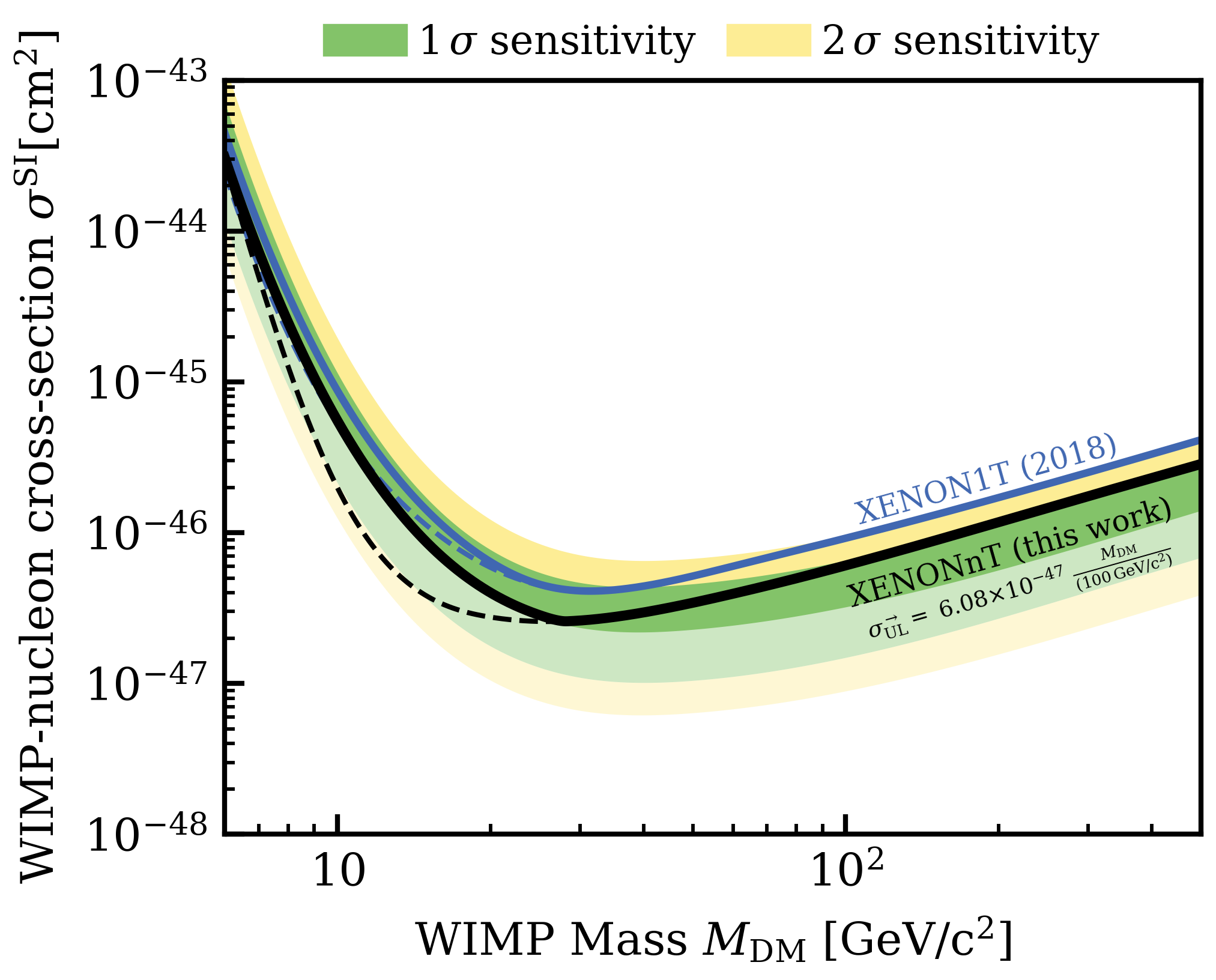
- Zoom (PNG, 313 KB)
- Figure: Limits on the interaction cross-section of WIMPs with individual nucleons as a function of the WIMP mass as set by XENONnT in 2023 (black) and XENON1T in 2018 (blue). The dashed lines indicate the raw limits while the solid lines represent the limits con- strained to the median sensitivity in order to prevent exclusion of parameter space beyond the experiment’s sensitivity. The 68 % and 95 % confidence intervals of the simulated sensitivity are shown in green and yellow, respectively.
Highlighted Publications:
- FirstDarkMatterSearchwithNuclearRecoilsfromthe XENONnT Experiment XENON Collab., Phys. Rev. Lett. 131 (2023) 041003
- Electron transport measurements in liquid xenon with Xenoscope, a large-scale DARWIN demonstratorXenoscope, a large-scale DARWIN demonstratoL. Baudis et al., Eur. Phys. J. C 83, 717 (2023)
- Final Results of GERDA on theTwo-Neutrino Double- β Decay Half-Life of 76Ge
GERDA Collab., Phys. Rev. Lett. 131 (2023) 142501
Prof. Ben Kilminster - DAMIC Experiment
DAMIC-M (Dark Matter in CCDs at Modane Under- ground Lab) is an experiment that searches for the dark matter gravitationally bound in our Milky Way through electrical signals produced from its collisions with sili- con CCD detectors. This experiment represents a factor of 10 increase in mass, a factor of 10 decrease in the energy threshold, and a factor of 50 decrease in background rates, as compared to the current DAMIC experiment operating in SNOLAB.
Our group helped found the DAMIC experiment in 2008. We are contributing readout electronics, mechanical compo- nents, and detector control and safety systems for the next phase, DAMIC-M. In 2023, DAMIC@SNOLAB took new data with improved skipper CCD readout, and confirmed a previously observed low-energy excess, now finding an excess with a significance of 5.4 Sigma. In order to understand the origin of the excess, the UZH group is pioneering a new tech-nique to distinguish between dark matter particles causing nuclear recoils and those causing electronic recoils. We de- scribe the characterization of the new scientific-grade CCDs in a new paper, and also describe a recent measurement with them, characterizing for the first time the Compton scatter- ing process on valence electrons with energy levels below 100 eV. DAMIC-M has been operating a prototype detector, while the complete detector is being constructed. With this prototype, we produced a new search for the daily modu- lation of dark matter, and excluded previously unexplored regions of the allowed parameter space for low-mass, dark matter, which interacts electromagnetically with the detector.
-
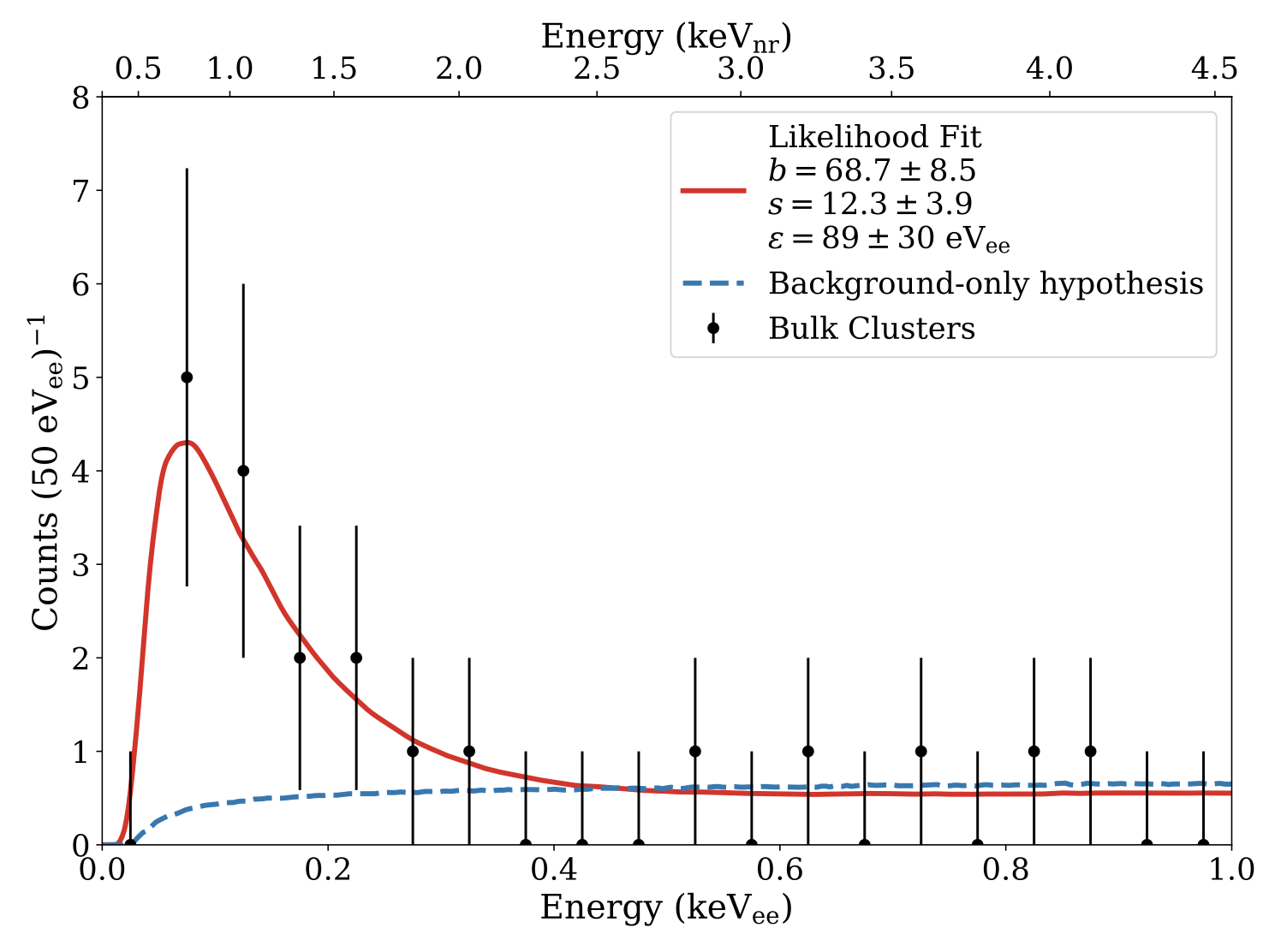
- Zoom (PNG, 180 KB)
- Figure: Data from DAMIC@SNOLAB (black points) show an excess above the background prediction (dashed blue line) that is consistent with a signal (solid red line) with a significance of 5.4 Sigma. The signal model is generically shown as a decaying exponential, taking into account the detector efficiency.
Highlighted Publications:
- Confirmation of the spectral excess in DAMIC at SNOLAB with skipper CCDs
DAMIC, DAMIC-M, SENSEI collab., arXiv2306.01717, accepted by Phys. Rev. D. - Search for Daily Modulation of MeV Dark Matter Signals with DAMIC-M
DAMIC-M collaboration, arXiv2307.07251, Phys.Rev.Lett. 132 (2024) 10, 101006. - First Constraints from DAMIC-M on Sub-GeV Dark-Matter Particles Interacting with Electrons
DAMIC-M collaboration, arXiv2302.02372, Phys.Rev.Lett. 130 (2023) 17, 171003. - Nuclear Recoil Identification in a Scientific Charge-Coupled Device
K.J.McGuire, A.Chavarria, N.Castello-Mor, S. Lee, B. Kilminster, et al., arXiv2309.07869, submitted to Phys.Rev.D.
Groups from the Institute for Astrophysics

As of January 2024 the Institute für Astrophysik has been established, gathering all groups working on theoretical and computational astrophysics and cosmology that were previously part of the Institute of Computational Science (ICS).
In the field of planetary science, the group of Helled contin- ued the efforts in preparing the science case for a Uranus mis- sion, in characterizing exoplanets, and in simulating planet formation and evolution. We also continued our involve- ment in space missions including Juno, JWST, Ariel and Plato. The group of Helled and Stadel together also made progress in simulating giant impacts using a new hydrodynamical method for non-ideal fluids.
Cosmological probes are affected by fluctuations of wave- length larger than the horizon scales. This infrared sensitivity in cosmological probes is canceled in general relativity (GR). Yoo’s group has quantified the general conditions for such cancellation in theory of gravity beyond GR. Research interests lie within the fields of cosmology and theoretical astro- physics, working on nonlinear structure formation as well as the astrophysical aspects of different dark matter models.
Collectively, groups at the institute made progress on one of the most active frontiers in astrophysics –– the study of galaxies in the young Universe. In addition to being involved in various observational projects with JWST, we made ad- vances in the numerical modeling of the physics of galaxy formation, including feedback from stars and supermassive black holes. The new state-of-the-art FIREBOX galaxy forma- tion simulation in a full cosmological volume, designed and performed by the Feldmann group has marked a new mile- stone in this field. In addition, we are developing generative machine learning methods for applications with the Square Kilometer Array Observatory (Feldmann group), and for the modeling of gravitational wave sources (Mayer group).
The groups of Feldmann, Mayer and Schneider are deeply involved in SKACH, the Swiss SKA Consortium, and contributed to obtain longterm funding from the fed- eral government to support swiss research in SKA. Together with groups at EPFL, UniGE and ETH, they also re- cently joined the Millimeter Wave Array (MWA), an Aus- tralian radio-telescope facility precursor of SKA. The ICS also hosted the main international swiss-based SKA meeting.
The group of Mayer, together with the team of Prof. Ciorba at UniBasel, managed to begin production mode with the first Exascale particle-based simulation code in astro- physics and cosmology, SPH-EXA, whose development has been funded over the past 6 years through the Platform for Advanced Scientific Computing and the Swiss National Su- percomputing Center. Owing to SPH-EXA, in October 2023 they were awarded the “EuroHPC Extreme Access Scale Award”, the largest ever supercomputing time allocation in Europe across all disciplines of science and industry. With that they are running, on the LUMI supercomputer, simula- tions of the turbulent interstellar medium and star formation which can resolve for the first time the full turbulent cascade down to the scale pre-stellar core formation.
Team members in Mayer’s group also made progress in the field of gravitational wave astrophysics, developing a new model for the origin of the first supermassive black holes in the early Universe, the dark collapse scenario, which gen- erates a gravitational wave burst detectable with the Laser In- terferometer Space Antenna (LISA), and showing how wave- forms generated by in-spiraling massive black hole binaries can be altered in a detectable way by perturbations form mat- ter surrounding the black holes.
-
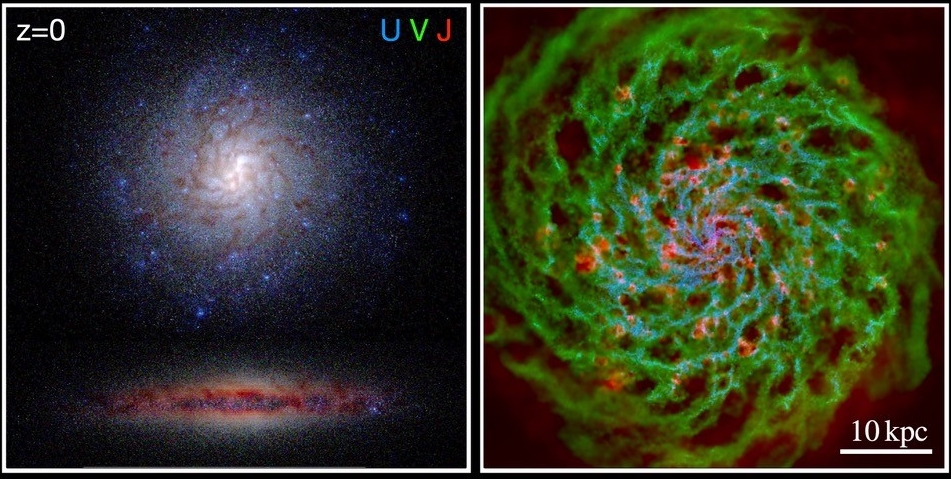
- Zoom (JPG, 388 KB)
- Figure: Visualization of the multiphase structure of the interstellar medium in one of many Milky Way like galaxy in FIREbox. (Left) Color composite image showing the stellar and dust components of the depicted galaxy in a face-on and edge-on view. (Right) Face-on, color composite image of the galaxy’s molecular (blue), atomic (green), and ionized (red) hydrogen content.
Highlighted Publications:
- Conditions for the absence of infrared sensitivity in cosmological probes in any gravity theoriesM. Magi, J. Yoo, Physics Letters B 864 138204
- Priorities in gravitational waveforms for future space-borne detectors: vacuum accuracy or environment?L. Zwick, P. R. Capelo, L. Mayer, MNRAS 521, 4645
- FIREbox: simulating galaxies at high dynamic range in a cosmological volume
R. Feldmann et al, MNRAS 522, 3831 - Towards a new era in giant exoplanet characterisation
S. Müller, R. Helled, A& A 669 id.A24, 11
Table of contents
- Prof. Philippe Jetzer - Astrophysics and General Relativity
- Prof. Prasenjit Saha - Theoretical Astrophysics
- Prof. Prasenjit Saha, Prof. Nico Serra - CTA – Cherenkov Telescope Array
- Prof. Laura Baudis - Astroparticle Physics Experiments
- Prof. Ben Kilminster - DAMIC Experiment
- Groups from the Institute for Astrophysics




